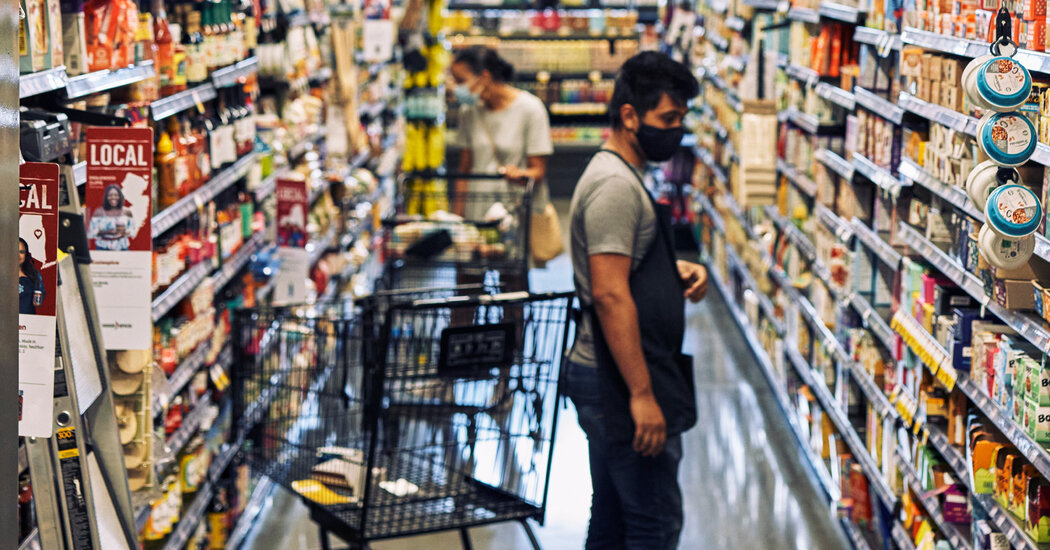The federal government plans to develop a new definition of ultraprocessed foods, a wide-ranging group of snacks, meals and drinks that have become a cornerstone of the American diet.
Nutrition researchers generally define ultraprocessed foods as industrially manufactured products that include ingredients you wouldn’t find in your own kitchen, like high-fructose corn syrup or hydrogenated oils. The products also often contain artificial flavors, sweeteners and emulsifiers that make them appealing to consumers and can give them a longer shelf life.
In crafting its own definition, the government could examine the chemicals and additives put in foods, the number of ingredients in a product or its overall nutritional content. That description could then be used to shape school lunch policy, regulate the foods available through federal services like the Supplemental Nutrition Assistance Program or make recommendations about limiting ultraprocessed food consumption in the U.S. dietary guidelines. The Food and Drug Administration, which is leading the effort in collaboration with the U.S. Department of Agriculture and other agencies, plans to seek public comment before setting a definition in the coming months.
Dr. Marty Makary, the commissioner of the F.D.A., said he expected the definition would encourage companies to label foods as “non-ultraprocessed” to entice customers, similar to how food manufacturers market their products as being free from added sugars.
“We do not see ultraprocessed foods as foods to be banned,” he said. “We see them as foods to be defined so that markets can compete based on health.”
The idea that consumers may go out of their way to avoid these items reflects growing concerns about the potential harms of ultraprocessed foods, which include many breakfast cereals, instant noodles, protein bars, meal-replacement shakes, flavored yogurts, hot dogs and more. Scientists have increasingly linked ultraprocessed foods to poor health outcomes, such as Type 2 diabetes, heart issues, some types of cancers and gastrointestinal issues.
Kyle Diamantas, the deputy commissioner of the F.D.A.’s food division, said that there were some “obvious areas” the agency would consider when crafting its definition, including synthetic dyes, emulsifiers and preservatives.
“We don’t have in our home kitchens these new novel ingredients that help a Twinkie stay on the shelf for six years or whatever it might be,” Mr. Diamantas said. He also suggested that a standard definition of ultraprocessed foods could be used for regulating the meals served to members of the military and at prisons and Veterans Affairs hospitals.
The government will almost certainly face pushback from some corners of the food industry, which has relied on preservatives and artificial ingredients to produce cheap, convenient foods at a large scale.
Any definition the government comes up with would be “hotly contested” by the food industry, said Marion Nestle, an emerita professor of nutrition, food studies and public health at New York University.
By defining ultraprocessed foods, the government will also weigh in on issues that have divided nutrition experts and confused consumers: Do plant-based meats and milks belong in the same category as sodas and candy bars? And are all ultraprocessed foods inherently unhealthy? Some, like various yogurts and whole-grain breads and cereals, contain valuable nutrients and have been associated with positive health outcomes.
The broad term can “demonize” foods that aren’t necessarily harming consumers, said Maya Vadiveloo, an associate professor of nutrition at the University of Rhode Island.
The federal push follows recent efforts in a handful of states to restrict ultraprocessed foods sold and served in schools. In Arizona, lawmakers defined ultraprocessed foods only as those with certain food additives, like artificial dyes. But additives may only be one part of what makes certain ultraprocessed foods unhealthy, said Brenda Davy, a professor of nutrition at Virginia Tech — and if the federal definition follows Arizona’s example, it would likely miss a great number of ultraprocessed foods, she said, like a sugar-loaded cereal that does not use certain food colorings.
“If their focus is too narrow, it may be limited in how much that might improve health,” she said.
Still, a federal definition would be a “big step forward,” Dr. Nestle said. It could pave the way for new types of warning labels, or for the government to regulate whether food makers could continue marketing ultraprocessed foods to children, she said.
“All of those are up for grabs if there’s a definition,” she said. She added: “It matters a lot.”






